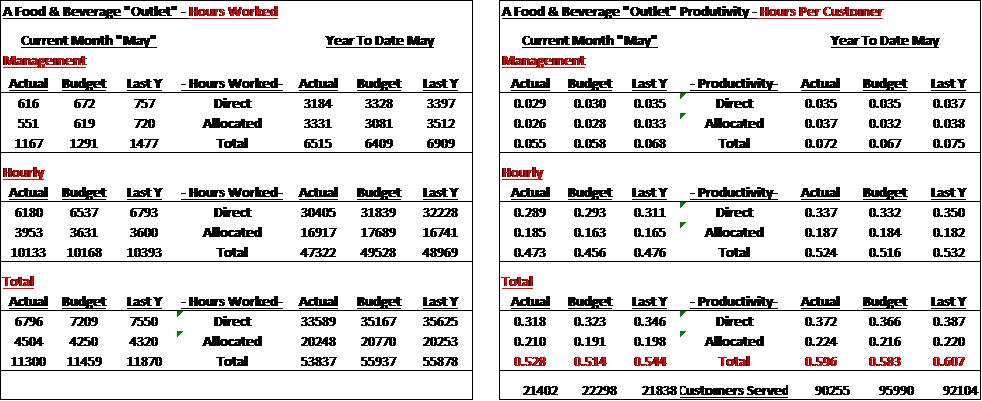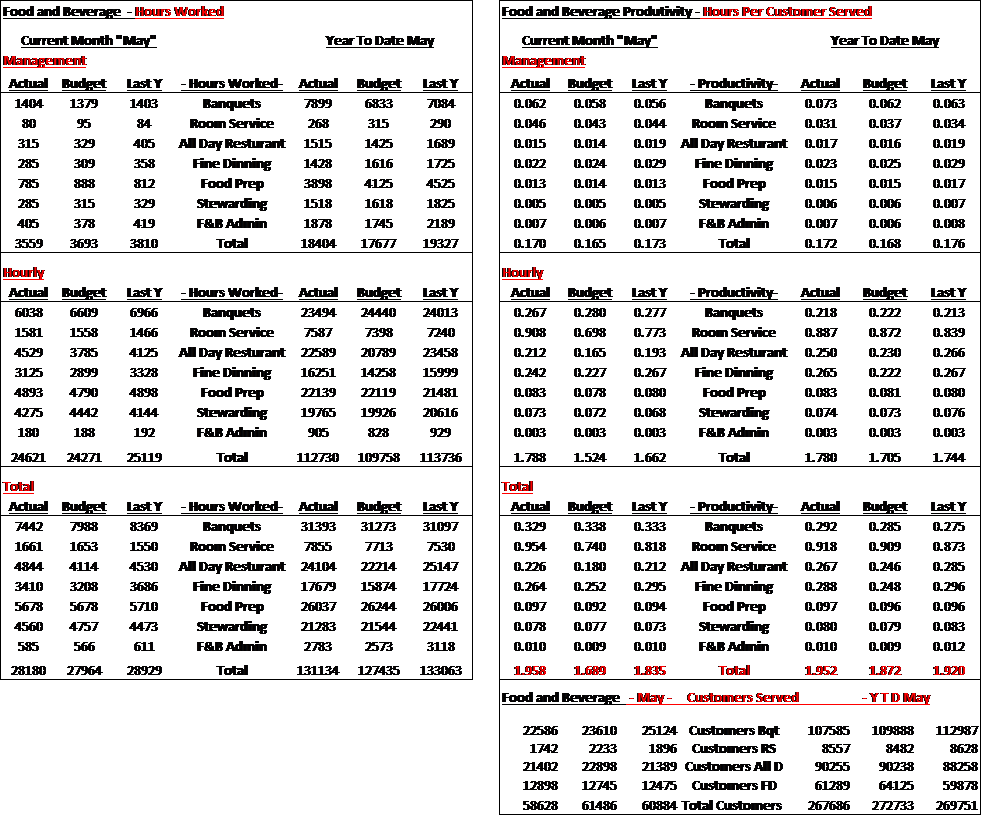Part II – Food and Beverage Productivity
In food and beverage, you want to get obsessed about a similar measurement as you do in the rooms division. In F&B it is “hours per cover served.”
 Right out of the gate you need to understand the definition of a cover and it has recently changed. A cover is now properly labeled as a “customer” and it is now calculated by dividing the total sales in all food and beverage items by the total number of customers. Before it was only food sales and you divided the number of people who consumed a food item by the total food sales. Now it is the total of warm bodies divided by total F&B sales. See Uniform System of Accounts for the Lodging Industry Eleventh Revised Edition (Hospitality Accounting/Financial Management) for more on this change.
Right out of the gate you need to understand the definition of a cover and it has recently changed. A cover is now properly labeled as a “customer” and it is now calculated by dividing the total sales in all food and beverage items by the total number of customers. Before it was only food sales and you divided the number of people who consumed a food item by the total food sales. Now it is the total of warm bodies divided by total F&B sales. See Uniform System of Accounts for the Lodging Industry Eleventh Revised Edition (Hospitality Accounting/Financial Management) for more on this change.
With productivity, the measurement is “hours per customer.” That is what you want to get obsessed about. Unlike the cover in the rooms division, a “customer” is or can be more challenging to record consistently and correctly than a room sold. Be diligent with the food and beverage service staff to ensure they record their “customers” correctly in your point of sale system. Reviewing point of sale guest checks will tell you very quickly if this is being done properly and consistently. One other tip is to closely review the daily revenue report and look for average covers by meal period that does not make sense.
Productivity in food and beverage is also best measured by dividing hours worked by customers served. Operations managers have no control over wages or pricing, but they do have control over schedules and this is where they should focus. The percentages and per cover/customer costs are important but the trump card is “hours per customer served.” What you need to see is this measurement in all budgets, forecasts, daily reports, and schedules. What is the F&B total productivity and how does it breakdown by outlet? You need stacks in each outlet that can stand on their own and you also want to see the consolidated results.
In F&B there is a bigger challenge than rooms with productivity creation. In F&B because of the multiple departmental structures and the allocation of management, food preparation and stewarding, things must be set up a little differently. Again, you are going to need your payroll dictionary and different classifications based on job title.
The first delineation is the people in operations who work on the floor vs. behind the scenes. All service staff for an outlet, both management and hourly, are considered “direct.” The hourly and management for food preparation, stewarding and F&B administration is considered “allocated.” To design stacks in F&B, use the following structure.
Direct and allocated both need hourly and management positions:
|
|
|
|
In banquets, there will be several additional hourly and management positions; however, the same hourly and management “allocated” positions will apply.
| Banquets Hourly Direct |
| All Wait Staff, Porters, House Person, Bus Persons, Bar Person, Bartender, Banquet Supervisor, Banquet Captain, Banquet Bar Supervisor, Office Coordinator, Payroll Coordinator, Revenue Clerk, Host, Hostess, Cashier, Banquet Secretary, Catering Coordinator, Administrative Assistant |
| Banquets Management Direct |
| Director of Banquets, Assistant Director of Banquets, Banquet Manager, Assistant Banquet Managers, Conference Services Managers, Assistant Conference Services Managers, Catering Managers, Assistant Catering Managers |
The results of these groupings and classifications are well worth the effort. On the chart below see an example of single outlet productivity; banquets would also look the same:

In food and beverage, you cannot get away from the allocation game. In your hotel, the most efficient way to manage your food cost and food labor is to have one main kitchen that prepares cold food, sauces, soups, pastries, banquets, and butchers the meat, etc. Then outlet kitchens prepare the final product, usually the protein through a combination of resources from the main kitchen’s efforts and their own.
The same idea is applied to stewarding and administration in the F&B division. Hotels that try to capture all the costs for food and labor directly for each outlet are ultimately not successful. They either spend too much time creating the separation and resulting duplication of efforts that the main kitchen scenario provides, or they pretend that they can capture the actual costs. Either way allocations of labor and cost of goods are inevitable.
In the end, the allocation method is ultimately the most efficient way to manage the labor in food and beverage.
What you need is an effective way to measure and manage in food and beverage. The “direct and allocated/management and hourly” is the way to go.
Inside the F&B consolidate statement you can see the individual outlet results, as well as the total for the allocated areas.

What you want to see in your daily operation is productivity. Have a daily labor analysis produced so you can track and monitor the productivity. Include these summaries in the financial statements each month. From that analysis, you can see where the hotel is winning with productivity and where the hotel is not.
In the scenario above for the month of May, I see the following:
- Banquets had a great month and are ahead of budget and last year, both hourly and management productivity is better with lower volumes of customers, well done.
- Room service had a poor result for May, lower volumes and more hours worked. This requires attention. What are we going to do about this ongoing challenge we have? How else can we provide our guests F&B services?
- The all-day restaurant also had a challenging month with the volume of customers flat to last year and below budget. I need to ensure my floor managers are adjusting the schedule where possible, sending people home early where possible. I need to emphasize again that every hour counts.
- The results in fine dining were mixed with an improvement over last year but below budget.
- Sundays are the problem and we need to look again at our need to be open on Sunday.
- Food prep is creeping up and it appears that little adjusting is being done. The new chef is more concerned with keeping his cooks happy with their hours than he is managing his productivity. I need to remind her again that labor productivity targets are part of her core responsibilities.
The information segregation and the framework outlined above give you a lens to see what is happening in your operation. It is up to you to use it and to manage the team and move in the direction of incremental improvement.
If you want a copy of my F&B Productivity spreadsheet send me an email
If you want a copy of my Rooms Productivity spreadsheet send me an email
To get a copy of my financial leadership recipe F TAR W send me an email
To get a copy of my Flow Thru cheat sheet send me an email
Visit my website today for a copy of my guidebook
The Seven Secrets to Create a Financially Engaged Leadership Team in Your Hotel
www.hotelfinancialcoach.com
Call or write today and arrange for a complimentary discussion on how
you can create a financially engaged leadership team in your hotel.
Contact David at (415) 696-9593
Email:
www.hotelfinancialcoach.com
